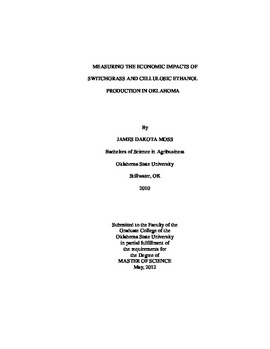| dc.contributor.advisor | Holcomb, Rodney | |
| dc.contributor.author | Moss, James Dakota | |
| dc.date.accessioned | 2014-04-15T18:35:35Z | |
| dc.date.available | 2014-04-15T18:35:35Z | |
| dc.date.issued | 2012-05-01 | |
| dc.identifier.uri | https://hdl.handle.net/11244/8335 | |
| dc.description.abstract | Oklahoma, being a major agricultural based state, will have the opportunity to become a large contributor to the production of alternative energy sources such as cellulosic ethanol from switchgrass. The goal of this study is to measure the economic impacts of switchgrass production for cellulosic biomass and the operation of cellulosic ethanol plants in Oklahoma. Utilizing results from a comprehensive linear mathematical programming model the locations for cellulosic ethanol plants and switchgrass production areas were found for nine different scenarios. With information on optimal plant locations and switchgrass production areas IMPLAN study area data and industry accounts are edited to show how the two activities will impact the study area. Also with a large agricultural cooperative presence in Oklahoma the model will show how different management practices such as coop owned vs. private ownership will affect the study area. In scenario one, for single plant additional impact assessments made for varying levels of cooperative and private ownership. By retaining plant profits in the region through cash patronage to producer owners cooperative ownership was measured for 50% cooperative ownership and 100% cooperative ownership. For the 100% privately owned no profits are retained in the region. For the 100% privately owned scenario there is a combined industry output for switchgrass production and ethanol production of 70 million, and a combined employment impact of 556 employees for the region. In the 100% cooperative owned scenario there is a combined industry output for switchgrass production and ethanol production of 86.1 million, and a combined employment impact of 726 employees in the region. Because of the induced impacts that result from the cooperative membership model industry output is 16.1 million higher than the privately owned and employment has 170 more jobs. In all other scenarios private equity ownership is assumed with the establishment of a single plant in the state and the switchgrass production area of only eight counties to supply it a combined economic impact for industry output of 70 million and an employment impact of 556 jobs from the two activities. In the ninth scenario switchgrass production and ethanol production have a combined industry output impact of 728.9 million and the total employee impact is 6,132. From the range of industry output and employment from scenarios one through nine the results show that the production of switchgrass for cellulosic ethanol production will have a large economic impact on the state of Oklahoma. | |
| dc.format | application/pdf | |
| dc.language | en_US | |
| dc.publisher | Oklahoma State University | |
| dc.rights | Copyright is held by the author who has granted the Oklahoma State University Library the non-exclusive right to share this material in its institutional repository. Contact Digital Library Services at lib-dls@okstate.edu or 405-744-9161 for the permission policy on the use, reproduction or distribution of this material. | |
| dc.title | Measuring the Economic Impacts of Switchgrass and Cellulosic Ethanol Production in Oklahoma | |
| dc.type | text | |
| dc.contributor.committeeMember | Kenkel, Phil | |
| dc.contributor.committeeMember | Shideler, Dave | |
| osu.filename | Moss_okstate_0664M_12145.pdf | |
| osu.college | Agricultural Sciences and Natural Resources | |
| osu.accesstype | Open Access | |
| dc.description.department | Department of Agricultural Economics | |
| dc.type.genre | Thesis | |
| dc.subject.keywords | biofuels | |
| dc.subject.keywords | cellulosic | |
| dc.subject.keywords | implan | |
| dc.subject.keywords | input/output | |
